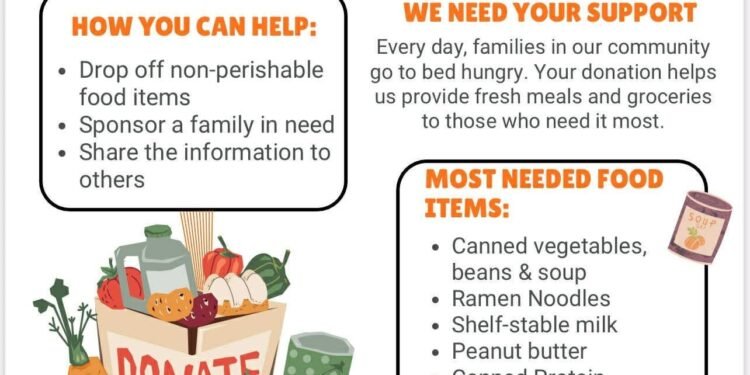Local organizations are both planning for ways to help Henderson families obtain food and stay afloat themselves if the federal government shutdown continues into November, when SNAP benefits will be stopped until the government can be re-opened.
“This is going to affect a lot of people drastically,” said Melissa Collier, the case manager at the Daniel Pitino Shelter Henderson.
She said it’s not an issue just for those who are homeless or at risk of becoming homeless, but also those who are working with roofs over their heads.
“It’s everyday working people trying to put food on the table,” Collier said.
Collier, the Henderson County Homeless Coalition and resident Taylor Heady are organizing a food drop-off at the warming box at Hays Boat Ramp. The first is from 10 a.m.-2 p.m. on Friday. The second is 10 a.m.-2 p.m. on Nov. 14. They are asking for non-perishable items.
People can pick up food at the same location on Nov. 3 and Nov. 21. On both days, the pick-up starts at 10 a.m. and goes until the food is gone.
United Way of Henderson County Executive Director Kelsi Dunham Johnston said UW is working with the Henderson Christian Community Outreach to assist those in need if the government shutdown continues. She has reached out to the businesses that support UW and asked that each provide groceries to the CCO.
The plan is still in the early stages and Johnston hopes that it doesn’t have to be implemented. But if the federal government does not reconvene, “we are going to make sure nobody is without,” Johnston said.
CCO Executive Director Susan Smith said her organization is in talks with not only UW but also the Tri-State Food Bank as the possible pause draws near. What makes it difficult on her end, she said, is that she doesn’t know for certain how many families and individuals will show up at CCO’s Fifth Street location starting in November.
“I don’t know what to prepare for,” she said.
On a typical day, CCO provides groceries for 40 people, starting at their 9 a.m. opening time. She said CCO might end up needing to serve 50 or 60 people in a day, and it might mean asking for more volunteers or keeping their doors open longer.
We’re “trying to work through our best plan of attack—if (the SNAP funding pause) does happen,” she said. “We’re going to do everything we can and meet the need.”
An Oct. 10 letter from the U.S. Department of Agriculture, which administers funding for SNAP—the acronym for Supplemental Nutrition Assistance Program—said that money is available through the end of October, but if the current lapse in appropriations continues, “there will be insufficient funds to pay full November SNAP benefits for approximately 42 million individuals across the Nation.”
In Kentucky, more than 600,000 residents receive SNAP assistance, according to a Monday release from Gov. Andy Beshear’s office.
“One in eight Kentuckians rely on SNAP, many of which are children and our must vulnerable,” said the governor in the release. “I know this is a scary and stressful time for our families, and we are committed to processing benefits the moment the federal shutdown ends and funding becomes available.”
Kendall Dean, the executive director at the Fr. Bradley Shelter for Women and Children, said 100% of current residents there are on SNAP. The shelter also has a food pantry that is utilized for residents who come to the shelter and don’t qualify for SNAP, which will be used if the shutdown continues, she said, adding though, it’s not an abundance of food, probably enough to “get us through the month of November.”
If the shelter were to run out of food, it would need to take money from its funds to pay for groceries for its residents. That, she said, most likely would mean that the shelter would need to cut operating costs and explore reducing staff and hours “to make sure folks can eat.”
Dean said loss of SNAP funding will affect many residents in Henderson, not just those women and children in the shelter.
“It’s time to think about your neighbor,” she said.
That’s a sentiment that Kace Campbell, the executive director at Audubon Kids Zone, echoed.
“As a community, we need to prepare,” she said, adding that 100% of the families that utilize the programs at AKZ are on SNAP.
She said loss of SNAP funding will be “devastating” for those families. She also rebutted a stigma associated with SNAP that those on the assistance don’t work or are lazy. She said all of the parents and residents that come to AKZ that utilize SNAP are working.
“These families are trying as hard as they can,” she said, and the loss of SNAP poses as “one more barrier” for them.
Nicole Frields, the chief operating officer of the Women’s Addiction Recovery Manor, said that SNAP is WARM’s revenue source to purchase food for 100 women there. SNAP also provides revenue for 100 clients at the Men’s Addiction Recovery Campus in Bowling Green, which is a part of the Center for Addiction Recovery of Henderson. Frields said the centers spend $22,000-$25,000 each month to feed their clients breakfast, lunch, dinner and a snack.
If SNAP goes away, “we’ll tap into reserves to make sure our clients are fed, but that’s obviously not ideal.”
And if SNAP were to be paused past November, Frields said that would cause WARM to pull back on projects to pay for food. Frields also serves on the Recovery Kentucky Housing Partnership and said she’s “super concerned” for all of the 18 recovery centers in the state that might be looking for the $25,000 or so per month to feed their clients.
Other organizations, such as the Harbor House Christian Men’s Center, said the SNAP pause will affect them, as well. Josh Bell, the executive director for Harbor House, said many of the men who stay there are on SNAP. He said his organization relies on community donations to feed the men who stay there. A SNAP pause will cause the Harbor House to lean on the community even harder, Bell said.
“This is only going to add more stress to the community,” he said.

























